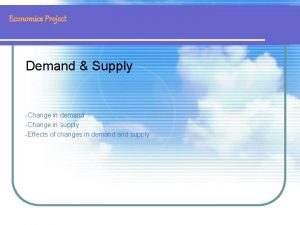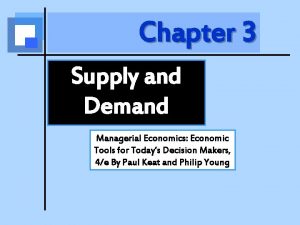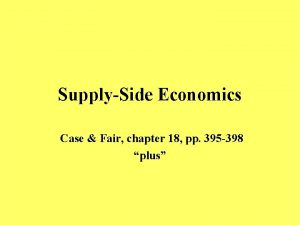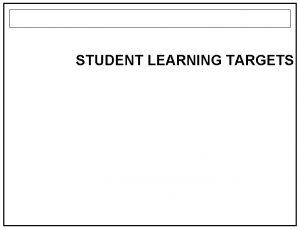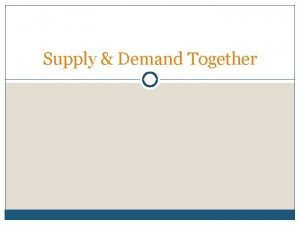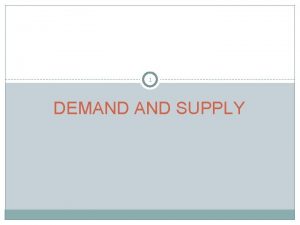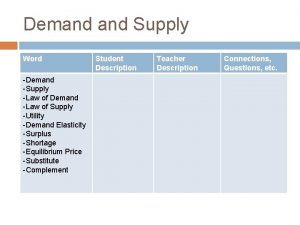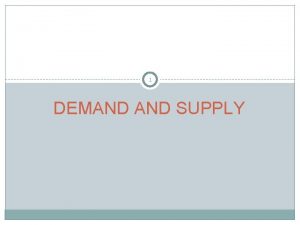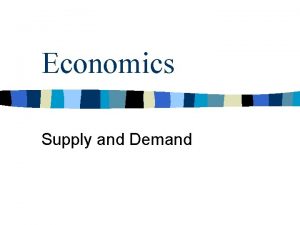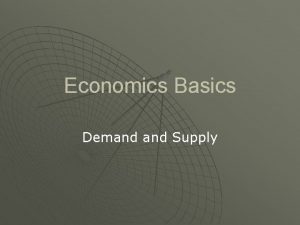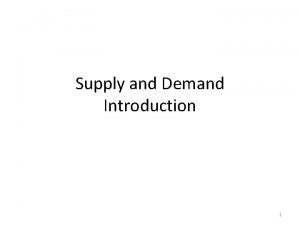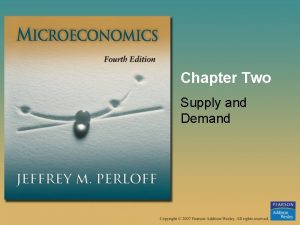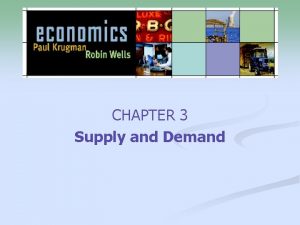Economics Economics Learning Targets Define supply and demand
















- Slides: 16

Economics

Economics Learning Targets • Define supply and demand • Draw a supply and demand curve and label the parts. • Demonstrate the relationship that prices play in supply and demand for different goods and services. • Define surplus, shortage, and equilibrium. • Label the parts of the supply and demand curve which identify shortage, surplus, and equilibrium.

What is Economics? • The social science that analyzes the production, distribution, and consumption of goods and services.

The Law of Supply • Law stating that in general, as the price of a good or service increases, the quantity of goods or services offered by suppliers increases and vice versa.

The Law of Supply

The Law of Demand • Law that states that, in general, as the price of a good or service increases, consumer demand for the good or service will decrease and vice versa.

The Law of Demand

Equilibrium • Equilibrium- the price at which the quantity demanded by buyers equals the quantity supplied by the sellers. Also: market-clearing price • At equilibrium, every buyer finds a seller and every seller finds a buyer

Shortage • Shortage- occurs when the quantity demanded for a product exceeds the quantity supplied. • Why? Price of the product is below the market equilibrium price. – The price is low enough where people will buy it up. – What SHOULD happen?

Surplus • Surplus- occurs when the quantity supplied EXCEEDS the quantity demanded • Examples? – What happens to the price in response? – Increase or Decrease?


Opportunity Cost • Opportunity cost-is the best alternative that we give up, when we make a choice or a decision. • Nearly all decisions involve trade-offs. • Examples?

Elasticity • Elasticity- is the measurement of how changing one economic variable affects others. For example: • "If I lower the price of my product, how much more will I sell? " • "If I raise the price, how much less will I sell? " • "If we learn that a resource is becoming scarce, will people scramble to acquire it? "

Complementary Goods • Complementary goods- are described as those goods that are used with another good. • Examples? – Peanut Butter & Jelly • A ↓ in the price of one good will result in ↑ in demand of both the goods. Conversely, an ↑ in the price will result in a ↓ of demand of both the goods.

Complementary Goods • Example of a complimentary good is pizza and pizza bread. Demand for pizza bread is proportional to demand for pizza. ↑ or ↓ in pizza demand will result in ↑ or ↓ of demand of pizza bread. • A perfect complement of a good one that MUST be used with another good. • Ex: A pair of shoes. • Ex: Computer & Software

Substitute Goods • Substitute goods- are those where one good can be used in place of other. • Examples? Butter and margarine. • ↑ price of one substitute good shall be accompanied by a proportional ↑ in demand of the other. • Conversely, a ↓in price of one will ↓ the demand of another. A perfect substitute is one that can be used in exactly the same way as its counterpart.
 Module 5 supply and demand introduction and demand
Module 5 supply and demand introduction and demand Matching supply with demand
Matching supply with demand Supply and demand economics project
Supply and demand economics project Supply and demand economics project
Supply and demand economics project Supply analysis in managerial economics
Supply analysis in managerial economics Supply side economics vs keynesian
Supply side economics vs keynesian Writing learning targets
Writing learning targets Learning targets
Learning targets Rough sketch and final sketch
Rough sketch and final sketch Sample learning targets for reasoning
Sample learning targets for reasoning Learning targets knowledge, reasoning, skill product
Learning targets knowledge, reasoning, skill product Learning targets helping students aim for understanding
Learning targets helping students aim for understanding Objectives of warehouse management system
Objectives of warehouse management system Identifying market segments and targets chapter 9
Identifying market segments and targets chapter 9 Identifying market segments and targets chapter 9
Identifying market segments and targets chapter 9 Identifying market segments and targets chapter 9
Identifying market segments and targets chapter 9 Four levels of micromarketing
Four levels of micromarketing



